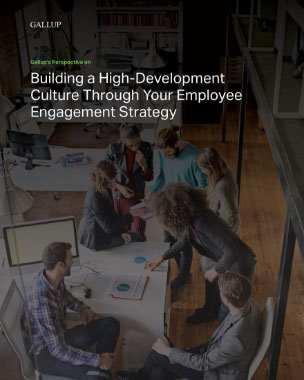Story Highlights
- Employee engagement swings up to record high
- Actively disengaged rate remains steady
- The sharp drop and rise of engagement has a precedent: the 2016 election
Gallup is closely tracking the engagement and wellbeing of the workforce during this unprecedented time of disruption. We are providing the latest updates for organizational leaders so they can understand the impact on the workplace and what their people need most during this time of rapid change.
Employee engagement in the U.S. has been on a rollercoaster ride.
In early May, engagement accelerated to a new high of 38%. And then, following the killing of George Floyd in late May and subsequent protests and riots, the percentage of engaged employees in the U.S. as measured from June 1-14 dropped to 31%.
Now, from our most recent measurement, the percentage of engaged employees -- those who are highly involved in, enthusiastic about and committed to their work and workplace -- has rebounded to a new high of 40%. This surpasses the measure's decade-long upward trajectory since Gallup began tracking the employee engagement in 2000.
The percentage of workers who are "actively disengaged" -- those who have miserable work experiences and spread their unhappiness to their colleagues -- remained approximately same level at 13%. The ratio of engaged to actively disengaged workers during late June to mid-July is now 3.1-to-1, also a new high. Just a month earlier, the ratio was 2.2-to-1. These findings are based on a random sample of 3,127 full- and part-time U.S. employees working for an employer from June 29 to July 12, 2020.

Line graph showing the U.S. employee engagement trend in 2020 so far. Surveys from March 9-23, 2020, show that 37% were engaged and 15% were actively disengaged. Surveys from April 27-May 17, 2020, show that 38% were engaged and 13% were actively disengaged. Surveys from June 1-14 shows that 31% were engaged and 14% were actively disengaged. And the most recent survey from June 29 through July 12 shows 40% were engaged and 13% were actively disengaged.
The remaining 47% of workers are "not engaged" -- they are psychologically unattached to their work and company. They're also on the lookout for better employment opportunities and will quickly leave their company for a slightly better offer.
Immediately following the civil unrest after the killing of George Floyd, the largest decline in employee engagement was among those in managerial or leadership positions, as well as non-White respondents and those with Democratic political party affiliation or independents. The drop was also sharper for people working on-site versus at home and among blue-collar or service workers. The drop was larger for men than women.
These declines in employee engagement appear to have been short-lived disruptions to the workplace. All the sub-categories where Gallup measured the most substantial engagement drops in early to mid-June, have seen substantial rebounds.
The recent drop in employee engagement was highly uncharacteristic, given the steadiness of past trends with only gradual improvements over time. Nothing has significantly dented employee engagement in the U.S. before -- not even past recessions of 2001-2002 or 2008-2009, the events of 9-11, or past pandemics.
In June, we noted that some of the possible reasons for the drop in employee engagement were likely the result of social unrest that created disruptions within workplaces, making it more difficult for leaders to attend to performance-related engagement elements. Diversity and inclusion challenges were heightened more than ever before.
Since mid-March, Gallup has been tracking the way employers respond to the coronavirus. From March to early April, from the employee's perspective, employers had improved in their communication and preparedness. The effectiveness of the employer response had since leveled off up until June, when employees said they felt much less prepared to do their work and rated employer and supervisor communication lower. Self-reported social distancing is also lower.
These declines in employee engagement appear to have been short-lived disruptions to the workplace. All the sub-categories where Gallup measured the most substantial engagement drops in early to mid-June, have seen substantial rebounds.
From late June into early July, employer communication and employee feelings of preparedness have improved by three percentage points overall and by six and seven points, respectively, for men -- a group that had reported the greatest declines in communication and preparedness in June. However, only 42% of employees strongly agree that their supervisor keeps them informed on what is going on in the organization -- unchanged from one month ago.
Workplaces Are Not Immune to Outside Influences
While the temporary drop in employee engagement -- and recent rebound -- is very uncharacteristic, it is not without precedent. Following the election of Donald Trump in 2016, Gallup reported a very temporary drop in employee engagement among Democrats, which shortly rebounded post inauguration.
This example from the recent past, though it doesn't represent as dramatic a change in employee engagement as this year's, reinforces a key point: While employee engagement tends to be highly stable, workplaces are not immune from outside influences.
Work and life are highly blended, arguably now more than ever with so many employees working from home amid the coronavirus pandemic. Leaders need to be cognizant of this fact, and that how they communicate during tumultuous times can make a big difference in how well their employees feel they are equipped to do their jobs. It's likely that managers and leaders have needed time to reevaluate their policies and practices regarding fairness, inclusiveness and promotion practices.
Combining Gallup's measurements for 2020 so far -- a sample of 24,132 U.S. workers -- 37% of employees are engaged and 14% are actively disengaged or a ratio of 2.6-to-1 engaged to actively disengaged workers. If this level of employee engagement were to continue until the end of 2020, it would represent another new annual high in the last two decades of Gallup's measurement.

Line graph showing the U.S. employee engagement trend in annual averages from 2000 through 2020. The percent engaged in 2000 was 26% and then it increased relatively steadily until 2019, when it was 36% engaged. The 2020 figure is based on three survey dates in 2020 so far, and the average percent engaged is 37%. The percent of U.S. employees who were actively disengaged in 2000 was 18%. This figure hit a high point in 2007 at 20% actively disengaged, but then continued a relatively steady decline until the 13% actively disengaged rating from 2019. The 2020 average so far is 14% actively disengaged.
Gallup will continue to track the engagement and wellbeing of the workforce during this unprecedented year of disruption and change, and continue to provide the latest updates for organizational leaders.
How engaged are your employees?
- Use Gallup Access to measure and improve engagement at your workplace.
- Become the resident expert. Keep learning about engagement.
- Develop your managers to drive engagement. Send them to Gallup learning.





